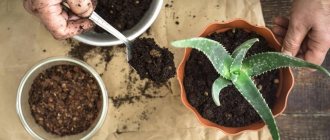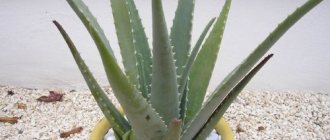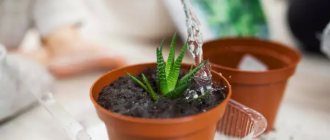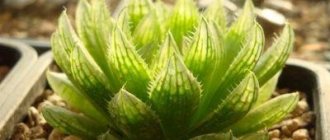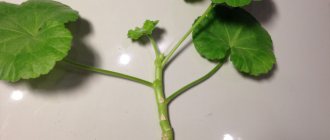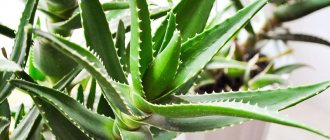Aloe (agagave) is a rather unusual in shape and very healthy indoor flower. Most often, the plant is grown precisely because of its healing properties. Aloe helps against many diseases and is successfully used in cosmetology. Sometimes it becomes necessary to grow several specimens at once. Therefore, it is very important to know how to propagate aloe at home. And it reproduces in several ways at once, which we will discuss in the article.
Timing for propagation of aloe 2. Methods for propagating aloe at home 2.1. Cuttings 2.2. Sheet 2.3. Apical shoots 2.4. Basal shoots 2.5. In water 2.6. Seeds
Photo by ru.depositphotos: Mother plant and children.
Advantages and disadvantages of the method
Is it possible to plant an aloe plant without roots? It is quite possible to grow agave in this way, although this method is not widespread among gardeners.
The method has its positive sides:
- the plant will have all the varietal characteristics of its “parent”;
- the rooted leaf grows quickly and forms babies that can be used for propagation (read more about propagation by babies here);
- planting can be carried out at any time of the year.
On a note. But this method is very expensive in terms of time and effort. In addition, in only 30-40% of cases, aloe without roots takes root.
Separation from the mother plant
The shoot is removed from the peduncle after it has grown at least 2-3 leaves and at least two pairs of roots more than 5 cm long.
The same must be done with the shoot that formed below, near the roots of the mother plant. When inspecting the root system, be careful - try to cause as little harm and damage as possible.
In general, it is not necessary to separate this process. You can leave it and in the future get two plants in one pot, which will bloom twice as luxuriantly.
If the shoot appears on the orchid stem itself, it is not touched and left on the mother plant.
The procedure for planting a shoot is carried out with a sharp, disinfected knife, scalpel or other cutting instrument. If it is not possible to carefully separate the shoot, it can be cut off along with a short fragment of the peduncle. The cuts must be treated with crushed charcoal or cinnamon.
Attention! It often happens that the baby, while still on the peduncle, tries to bloom. This should not be encouraged under any circumstances - the flower stalks of children must be removed without fail.
Are there any chances of success?
While propagating and growing aloe from a rootless leaf is not an impossible task, the chances of it growing roots are very slim. The fact is that the leaves are saturated with moisture and tend to rot before their roots begin to form. You will find more nuances on how to grow aloe from a leaf in this article.
How to grow at home?
Now we’ll tell you step by step how to plant aloe without roots. The main methods here are as follows.
Place the leaf in water, then in soil
This method of growing aloe without roots is the most common. Let's look at how to grow a shoot from a leaf for subsequent planting. The following steps must be observed:
- Prepare a glass container for the leaf, pour settled water at room temperature into it and install the planting material.
- As soon as the roots appear, remove the leaf from the water and place it on a clean cloth.
- Leave the planting material in a warm place so that the film has time to form. This may take 2-3 days. The resulting film will protect the plant from soil infection.
- After this, you can transplant the plant into a prepared container with a drainage hole and 2/3 filled with substrate.
The planted shoot does not need to be heavily compacted with soil, and after planting it should be watered with settled water. Place in a dark place for 2-3 days.
What to do if a flower does not produce roots in water?
On the question of how to dissolve the roots of the agave in this case, the opinions of flower growers differ. Some say that cut leaves, if planted in water before planting in the ground, will certainly produce roots. Other flower growers are convinced that leaves rot when left in water for a long time, so it is better to plant them in the ground immediately. So the choice remains with the florist. In any case, if the method turns out to be ineffective, then the rapid reproduction of aloe will allow this procedure to be repeated without damage to the population.
Straight into the ground
This method is standard, and to implement it you must adhere to the following recommendations on how to grow roots:
- Cover the surface of the soil for planting with sand. It is better to use coarse grain, and its thickness should be approximately 2 cm.
- The fleshy leaf, dried for 2-3 days, is immersed in the ground with its lower part. The immersion height will be 2-3 cm.
- Using small leaves, cover the surface of the earth, pressing slightly.
- At first, watering should be replaced with banal spraying.
- After 8 weeks, when the first roots form, irrigation should be eliminated.
- As soon as the root system is developed, transplant the plant into soil intended for succulents.
- The surface of the ground can be sprinkled with a mixture of sand and expanded clay chips.
Is it possible to plant aloe without roots?
Propagating agave by planting aerial parts in separate containers is the most popular way of propagating it. This method is less effective than propagation by budding, but it is much more “clean” - it does not require removing the plant from the pot. For planting without roots, take leaves, cuttings and tops of stems.
The procedure is performed as follows:
- Cut a piece of the plant closer to its base.
- Treat the cut with activated carbon or wood ash.
- Place the seedling in a cool, dark place.
- After the cut site stops releasing juice, you should place the shoot in well-moistened sand.
Within 10-14 days, the seedling will acquire its own roots and turn into a full-fledged plant.
Can it be placed in open ground?
You can transplant an aloe leaf into open ground, but only for the summer. If the spring in the region is warm and there are no frosts, then planting work should be carried out at the end of May.
It is important that the daytime temperature is 25-30 degrees, and the night temperature does not fall below 12 degrees.
Transplanting aloe into open ground is carried out as follows:
The first step is to choose a landing site. It should be carefully lit, but only direct sunlight is unacceptable.- You also need to make sure that the aloe does not get wet during rain, otherwise it will rot.
- Once the location has been selected, you can dig a hole, the size of which will be slightly larger than the size and depth of the pot where the plant is located.
- Send sawdust or coal to the bottom, and sprinkle a layer of expanded clay on top. This layered “pie” is completed by a ready-made earthen mixture.
- Place the plant in the prepared hole and sprinkle with nutritious soil mixture.
Propagation by seeds
Varietal aloe seeds are sown in February-March. To do this, take a wide container, on the bottom of which a drainage layer of expanded clay is laid, and on top - a soil mixture.
The required soil composition for germinating aloe seeds should be light and contain leaf soil, turf soil and sand in a ratio of 2:1:1.
Aloe seeds are sown in a container and lightly sprinkled with soil .
It is necessary to maintain low constant soil moisture and a temperature of about 22°C. Shoots appear within 3-4 weeks. When they grow a little, they are transplanted into separate pots with the same soil composition.
To obtain good varietal aloe, you need to use only purchased seeds.
When germinating seeds from your own plants, specimens may grow without any indication of your plant variety.
Aftercare
- Watering.
Aloe tolerates drought better than too much moisture. The plant is able to accumulate moisture in the leaves, so that it can remain without precipitation for some time. Young plants need to be watered once a week, and then the frequency of watering is reduced to once every 2-3 weeks. - Lighting.
Aloe fully develops only under conditions of intense lighting. It is better to place the flower pot on a south-facing window sill. If the plant does not receive light, its leaves will begin to grow unevenly and will become curved. - Temperature.
The flower grows actively at room temperature and can withstand a range of 12-30 degrees. In summer, pots can be placed outside or on the balcony. With the onset of winter, be sure to move them indoors. The frequency of watering will depend on the air temperature.Note! The warmer the room, the more water the flower will need.
We talked about other methods of propagating aloe in these articles:
- What are the secrets of growing aloe from seeds?
- Features of propagation of aloe by cuttings.
Preparing for transplant
How to plant an orchid: examples in a pot and at home
The bush must be replanted carefully, following all the necessary recommendations. If everything is done correctly, the plant will not be injured, will survive the soil change well and will resume growth very quickly.
Attention! Before transplanting, aloe needs to be watered abundantly for several days. In this case, it can be easily removed from the pot without damaging the root system.
Choosing a pot
The choice of pot must be approached very responsibly. Its size completely depends on the reason for which the plant is transplanted. If it is young, has a powerful and well-developed root system, then a larger container needs to be selected. If the aloe has young shoots, then the plant can be left in the same box (provided that the shoots have been removed). You can take a slightly smaller pot if the transplant is done due to rejuvenation (in this case, the affected or dead parts are removed).
All pots should have holes in the bottom for drainage. If they are present, the soil will not become sour. The old pot must be washed before further use.
Aloe in a pot
Soil quality
The new soil should be as close as possible to the previous one. Ideal if you buy it in one store. The packaging of aloe soil should indicate that the substrate is prepared specifically for succulents or cacti. The soil must be loose. When preparing soil for aloe yourself, sand is added to the leaf and turf soil.
What to do if it doesn’t take root?
If the plant does not take root, the following recommendations will help solve this problem:
- Use soil from the forest for planting. It is the most nutritious for plants.
- Plant a leaf with roots in dry soil and do not water it for 7 days, and then pour water into the pan.
- Do not water aloe immediately after transplanting. Then it will take root faster, and if you fill it with water, there is a danger of the roots rotting.
Growing aloe from a leaf without roots is a difficult task, but quite doable if you try hard. Taking into account the recommendations presented, you can successfully propagate aloe leaves, saving personal time and effort. And under no circumstances should you worry if this procedure is not successful the first time, because you can always try again.
Interesting Facts
@Rest-Dvor.ru
Aloe is unpretentious and tolerates any conditions, but does not refuse favorable ones, which has a great effect on its growth and leaf color. It can withstand a long time without watering. And if the leaf turns yellow and it seems that the plant will no longer come to life, then after careful watering it becomes green again and increases in growth. The plant likes cool weather and does not like direct sunlight. It can be taken out into the open air from spring to autumn, but you need to make sure that it has enough light.
Important! If aloe does not have enough of it, the leaves fade and curl.
ATTENTION!
The information on the site is for informational purposes only and does not call for action. Remember, self-medication can harm your health. Before using medicinal herbs, consult your doctor.
